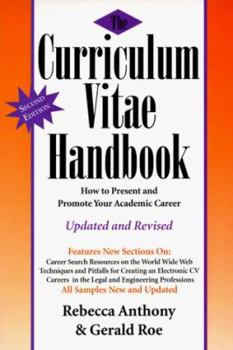The Curriculum Vitae Handbook: How to Present and Promote Your Academic Career
No Synopsis Available.
Format:Paperback
Language:English
ISBN:0945213263
ISBN13:9780945213260
Release Date:January 1998
Publisher:Rudi Publishing
Length:166 Pages
Weight:0.70 lbs.
Dimensions:0.4" x 6.3" x 9.3"
Customer Reviews
2 ratings
Quick, Direct, and to the Point
Published by Thriftbooks.com User , 22 years ago
In all my years in both academic and professional circles, it still surprises me that many people, from graduate students and professors to high-powered CEOs and executive directors of non-profit organizations, do not know how to prepare and present their sterling qualifications on paper. As such, this explains the vital importance of Anthony and Roe's Curriculum Vitae Handbook. By now, one might imagine that the content of this outstanding book to be de riguer among academics and professionals, and that at best, the book can only guide the reader in the preparation of a CV that does not stand out in a bad way. Nonetheless, given the considerable compositional and quantitative faux paus I have witnessed many individuals make in the preparation and presentation of their CVs, I sincerely believe that this text is a critical component of any aspiring and seasoned professional's arsenal. After defining exactly what a CV is, the book offers a few terse paragraphs on a variety of topics that include, but are not limited to, things such as promoting and using the CV, CV format, length, and content, and the nuts of bolts of preparing the CV. The text really emphasizes revision in the CV writing process, and warns the reader against putting down on paper anything and everything one has done in the final CV document that is destined for distribution. The book tells the reader that apart from the three most critical elements of a CV and a standard resume (name, address and educational attainment), good judgment, common sense, and the position one seeks dictate what should be included in the final document. The authors note that what should and should not go into the final draft, as well as how the final draft of the CV appears from the presentation standpoint, will naturally change over time.They also admonish against the use of standard, cookie-cutter formats when presenting the content of a CV, as this may place onerous constraints on someone whose achievements may not be adequately accommodated by the prevailing CV style in one's field. The authors emphasize the general, though very important rule of content first, style second. The book really pays for itself, however, with its extensive sample CVs, and manages to present one CV for just about every conceivable academic discipline. Along with each sample CV comes a few useful pointers, or strategic features, to help the reader optimally tailor the CV content for his or her particular discipline. Once the CV has been prepared, the authors show the reader how to go about turning the CV into a standard resume. A final section on the drafting of suitable cover letters rounds out the text, and the authors include two appendices covering contact information for professional societies and a brief resource list.Aside from the overtly terse nature of the text and its simplistic economy of prose (which I find to be a good thing), the book has three minor disadvantages. Written before the entrenchment
A good handbook!
Published by Thriftbooks.com User , 24 years ago
For people who are in academia, you know you need to write a good CV to get a job. This book help you to create a good CV with useful information to your future employer. It also provide some useful information about CV Format, The Model CV, CV Length, CV Content and so on. If you are looking for a professor job, this is a must read.






